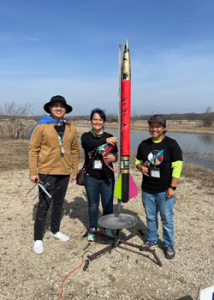
Undergraduate students at the University of Hawaiʻi at Mānoa have the opportunity to get involved in space exploration and research through academic programs and internships offered through the Hawaiʻi Institute of Geophysics and Planetology (HIGP).
Three students who are currently enrolled in the Earth and Planetary Exploration Technology (EPET) certificate have explored research opportunities through internships with HIGP and Hawaiʻi Space Grant Consortium (HSGC) and have contributed to space exploration through fields such as physics and engineering.
Student experiences

Stephan Devis, a junior pursuing a bachelor of science in physics, works on the Mastcam-Z instrument aboard NASA‘s Mars 2020 Perseverance rover. The Mars 2020 project is in collaboration with Sarah Fagents, a volcanologist at HIGP and a co-investigator on the Mastcam-Z instrument.
“It was thrilling to be so involved in the delta campaign of one of the most momentous missions of our lifetime,” said Devis.
The experience Devis is gaining on the tactical operations team for Mars 2020 is applicable to the operations of any future mission.
“One of my career goals is to become a planetary scientist and to contribute to the future of space exploration and to a crewed mission to Mars,” said Devis. “The research opportunities I have found here at UH Mānoa are directly in line with these goals and are equipping me with skills that will put me in a better position to achieve them.”
Matthew Paulino, a junior in mechanical engineering with an aerospace concentration, is an HSGC intern where he has been able to apply mechanical engineering concepts to understand the process of creating a scientific instrument.
These opportunities provided Paulino with an understanding of what it takes to create scientific instruments, from management level of understanding to engineering applications.
“EPET is a unique opportunity for me because it gives me experience from the perspective of not only an engineer but also the perspective of scientists,” said Paulino. “In other words, scientists commission the engineer to create a scientific instrument and the engineer needs to understand what is needed from the scientist.”

Katlynn Vicuña is a senior in mechanical engineering with an aerospace concentration. As an HSGC intern, Vicuña has gained space exploration experience through working with vertically integrated project teams on satellites and rovers, she worked on a rocket team with a space grant through the NASA First Nations Launch, and worked as an Hawaiʻi Space Flight Lab avionics assistant.
“It has been important because this has opened up my path to apply for Brooke Owens Fellowship where I was able to get an internship with Lockheed Martin Space for summer 2022,” said Vicuña. “Without these hands-on experiences, I do not think I would have been hired or chosen.”
More on EPET certification
EPET consists of four sequential courses in which undergraduate students form a team, develop a CubeSat mission concept, and then go on to design and build it as a capstone project, with advising from Peter Englert and others.
The EPET certificate program is for students enrolled in science and engineering undergraduate degree programs at UH Mānoa, UH System campuses, and other universities. The program can also accommodate professionals working in the community who wish to upgrade knowledge and skills.
The next cohort of students for the EPET certification program will begin in spring 2023. For more information, see HIGP’s website.

